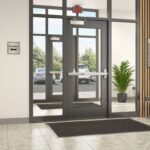On Tuesday I published a post asking for your input on how to handle a fire-rated stair door that needed new access control. Then because of technical difficulties I couldn’t approve your comments. I have now posted all of the suggestions and I think this topic could benefit from a little more discussion. To refresh your memory, here’s the description:
You have an existing single door swinging into a stairwell, with a 90-minute fire rating. The door has fire exit hardware with non-locking trim on the stair side, and the owner wants to add access control to prevent unauthorized people from entering the tenant space from the stairwell. The existing hollow metal frame is filled with grout, and prepped for 3 hinges and reinforced for a roller strike. The existing hollow metal door is prepped for rim fire exit hardware – a Von Duprin 99L-F-BE. The code that applies to this renovation is the 2015 edition of the International Building Code.
 The possible solutions posted by iDH readers included electrified lever trim, electric latch retraction, delayed egress, a direct-hold electromagnetic lock, a networked wireless lock, or an electric strike. My preference would be to replace the existing passage lever trim with a fail safe electrified lever trim – in this case the Von Duprin E996-L. Here’s why:
The possible solutions posted by iDH readers included electrified lever trim, electric latch retraction, delayed egress, a direct-hold electromagnetic lock, a networked wireless lock, or an electric strike. My preference would be to replace the existing passage lever trim with a fail safe electrified lever trim – in this case the Von Duprin E996-L. Here’s why:
- Because this is a stair door we need to be able to remotely unlock the stair side lever to allow building occupants to leave the stair during a fire. Whether this remote unlocking is accomplished automatically via the fire alarm system or by a manual switch at the fire command center depends on which code is being used, but either way I would use a fail safe electrified product. There should not be a problem prepping the existing fire door for the new E trim, because according to the template the only difference would be the cylinder hole, which is within the allowable job-site modifications according to NFPA 80.
- A fail safe electric strike can’t be used on a fire door, so there are very limited locations in a stairwell where an electric strike is acceptable by code.
- I have not seen wireless products used on many stairwell applications. The codes don’t specifically prohibit wireless locks, but the code officials may have some concerns with technology that is unfamiliar to them.
- While a delayed egress mag-lock could be used to unlock the door remotely, someone could also turn the lever on the stair side of the door, pull on the door, and enter after waiting 15 seconds. Delayed egress may not be allowed on the door leading into the stair, depending on what type of occupancy we’re dealing with – the IBC does not allow delayed egress for doors serving Assembly, Educational, or High Hazard occupancies.
- Electric latch retraction can be added in the field, but the codes require stair doors to unlock without unlatching to allow reentry during a fire alarm. An EL/QEL device could be unlocked remotely if power was applied, but it would also unlatch. And if power was cut, the door would be locked from the stair side (assuming the existing passage lever trim was replaced with a locking trim).
- A mag-lock is a good option for existing doors, but the required release devices must be included in the system. If a motion sensor is used to release the mag-lock, there can be problems with corridor traffic accidentally unlocking the door by activating the sensor. Another thing to watch out for…there was some confusing language in past editions of the IBC, which stated that Access Controlled Egress Doors could be used on entrance doors and tenant entrance doors. Some AHJs have interpreted this to mean that mag-locks can’t be used on doors that are not main entrances. This code language has been changed, and the are obviously mag-locks installed on many doors that are not main entrance doors, but the misconception still exists in some jurisdictions.
A few more questions for y’all…
- Have you seen wireless products used on stairwell doors? If yes, what safety requirements were applied?
- Is there a door loop available that is listed for use on a fire door assembly?
- If a frame is grouted, how difficult is it to add an electric hinge?
- To avoid field-drilling a raceway in the door, can the wires be run inside of the panic hardware?
- If an acceptable door loop is available and the wires can be run inside of the panic hardware, can the door loop attach directly to the panic bar or does it have to attach to the door?
.
What else?
You need to login or register to bookmark/favorite this content.






I agree completely with you. The E996 trim is the correct answer. We have used it MANY times with no negative feed back from owners or local authorities.
Our fear with wireless is they could fail in a secure mode and affect life safety.
The wiring for Von Duprin E996L is run through the rail per the installation instructions. Adding this does require a 1/4 inch hole in the face of the door at the tail end of the device, but I believe this is not in conflict with Code. Adding an electrified hinge to a grouted frame is not that difficult, but it does require skill and proper tools.
I wouldn’t call adding the electric hinge “difficult” more so tedious. We have to cut in electric strikes all the time into grouted frames. It just takes awhile to chip out the grout.
I have used the E996 and the AD300 996 for this application. I would not hesitate to use the AD400 996 (wireless) version. In all cases the lock must be set up fail safe. With regards to the AD series…. programming allows you to set them up fail safe on comm loss. Re-entry provided by a fire alarm input to the access control system.
I have used door cords in all of the configurations you described (mounted on the end cap on push side and door on pull side). This was prior to NFPA 101, 2007 being published. I did check with the door manufacturer at the time and they were okay with it. However, I do see need to revisit the assembly question as it relates to the door cord.
Maybe Von Duprin could come up with an end cap that has a built in door cord and is tested for fire labeling for instances such as this.
That’s an interesting idea!
– Lori
thinking out loud:
A door loop could be deliberately damaged if located pull-side. Since trim is fail-safe, bad guy would gain entry when the circuit is broken.
Locating the door loop push-side could be less than visually desirable, but I’ve seen some “not-too-bad-looking” installations: cord was swung from frame to device end-cap, wire was run through the device’s rail as described by Joe Folcarelli.
Challenge w/ wireless is device’s response time. The device is periodically sync’d with the central station every “x”number of minutes, i.e., it’s not “real-time”; this lag period between sync events is likely too long to satisfy an AHJ. When the alarm system goes into alarm mode, the AHJ typically wants immediate unlock.
I agree w/ Bob Larson: a wireless device could possibly unintentionally fail in a locked mode.
When I worked for a distributor and had electrified exit device retrofits to be installed one of our techs attached the door cord at the end of the rail on the bottom side. It was a nice clean look without drilling into the door.